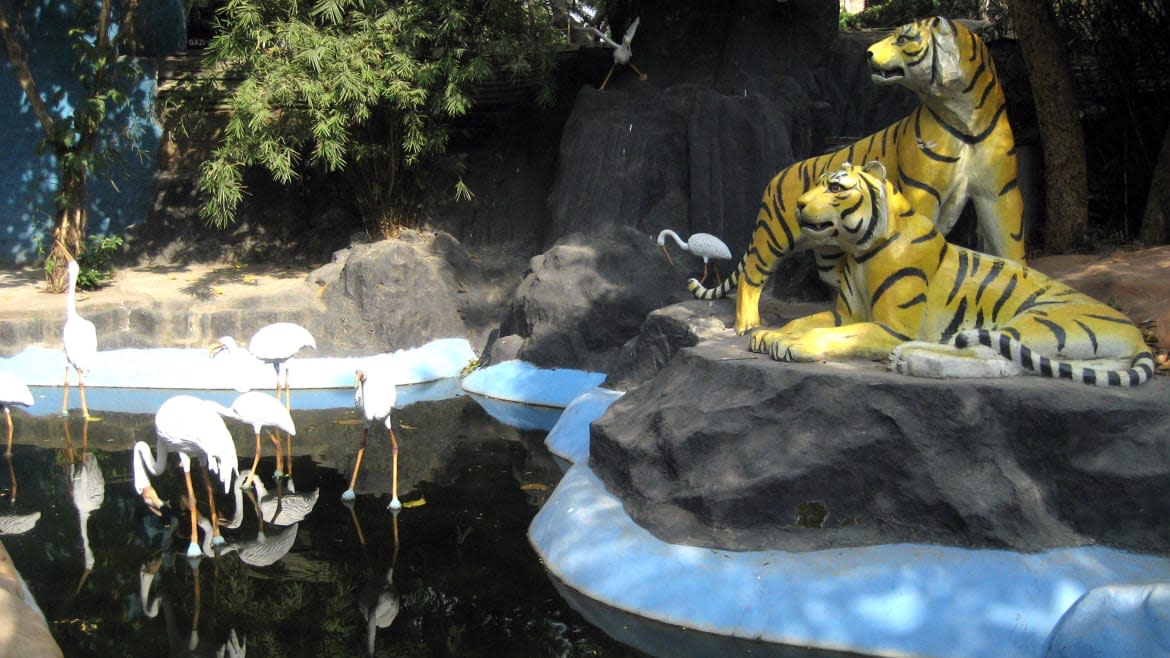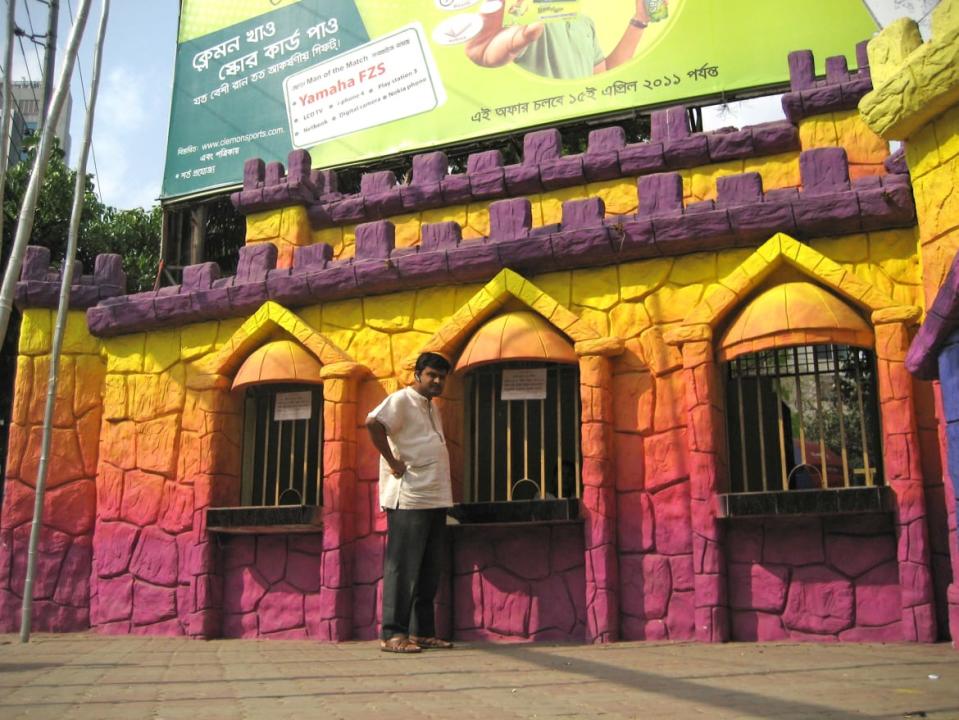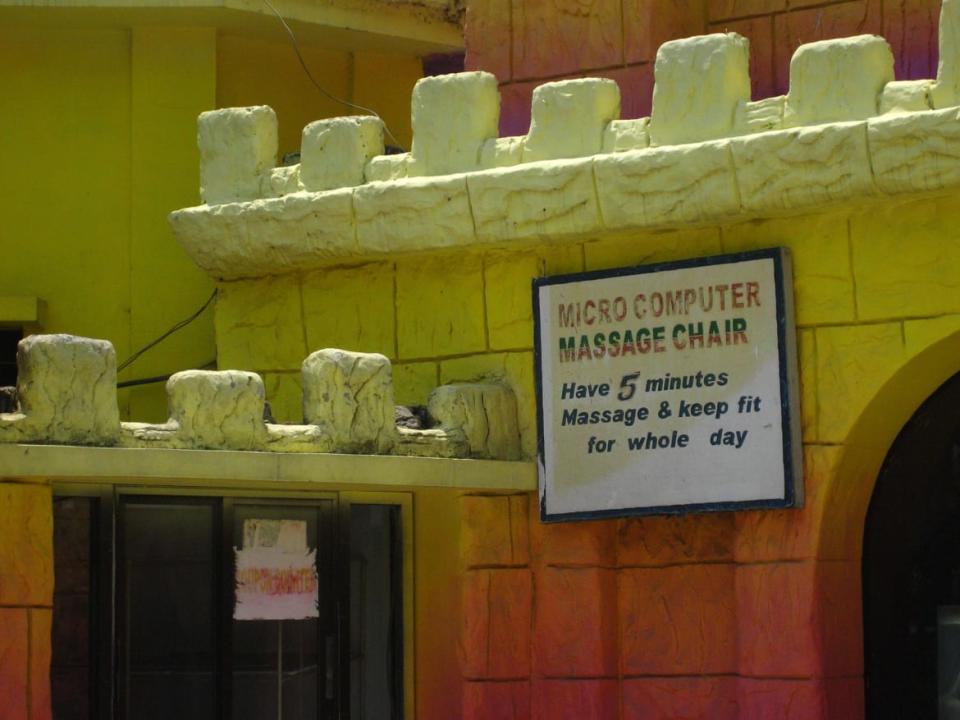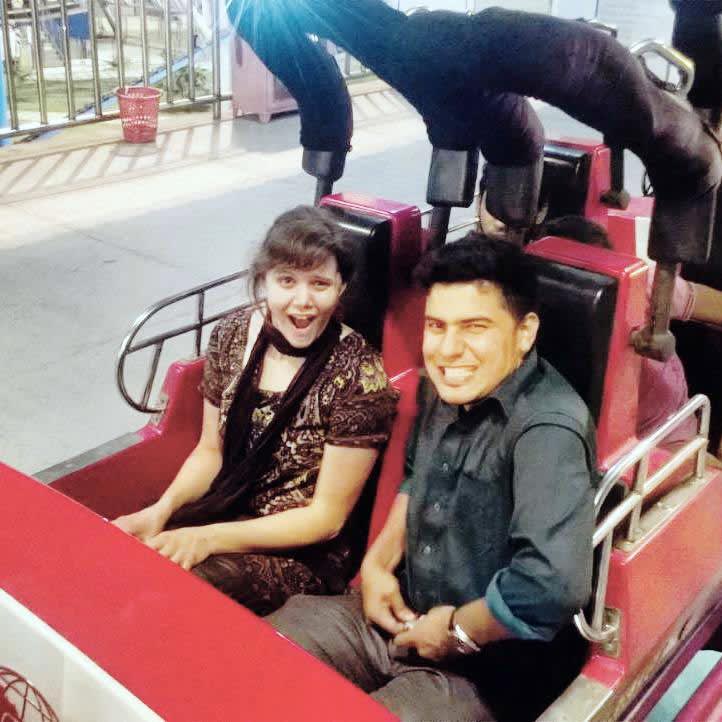Food in Metal Kidney Dishes and Ghost Restaurants: Kitschy Theme Parks and Restaurants Are Dhaka’s Best Sights

The faded yellow, orange, pink, and purple facade of a faux-rock castle stared daily at me from the window of a car stuck in traffic. Wonderland, a sign in bright rainbow colors, called out among painted foam turrets and tie-dyed battlements. What else was behind those portcullis-ticket booths?
Across the street from Wonderland, a pile of fifteen junk-cars, covered in years of dust, blocked the sidewalk of a mosque. A beggar with both legs amputated slid around on a miniature furniture dolly, maintaining a slow crawl while being aggressively ignored by pushing crowds, passing rickshaws, children knocking on car windows to sell flowers, and bored-looking teenage security guards clumsily carrying rifles.
This is a neighborhood known as “Circle One” (because there is a giant roundabout circle nearby) in the expat embassy district Gulshan, in Dhaka, Bangladesh.

Unless you’re a bleeding-heart humanitarian worker, Dhaka would never make your bucket list. The massive city houses more than 15 million people in cardboard slums, concrete apartment block cells and quickly-constructed high-rises, built 10 feet apart, with massive tangles of electric cables dangling precariously near windows, above rickshaws, between buildings, and sometimes just above one’s head. All residents are subject to the same daily power outages (mitigated by generators in more posh quarters), outdoor food stalls buzzing with flies, relentless mosquito bites and foul-smelling air, thick with the burning plastic that is Dhaka’s main source of trash disposal. Its ancient buildings are hard to navigate among the beggars on the street, and any architectural or visual details have probably been stolen or destroyed by now. Don’t let Lonely Planet entice you with its number-one recommendation, a visit to the Sundarbans. It’s a mangrove forest that claims wild, unfettered access to the nearly-extinct Royal Bengal tiger. Instead, its tall, crude cages trap deer and monkeys in what feels more like a limited-access zoo. When it comes to royalty, you are more likely to see a member of the British royal family than one of the 300 remaining tigers.
I went to Dhaka to freelance for a local media company, specializing in branding and communications for NGOs. In 2006, when I made my first trip, Bangladesh frequently appeared on the world’s most depressing lists. The country scored eighth from the bottom of Transparency International's Corruption Perception chart, was named one of the fifty least-developed countries by the United Nations, and, according to World Bank data, Gross National Income per capita was around $560. Local women were an uncommon sight on the streets. In 2005, the US State Department reported that 50% of Bangladeshi women were victims of violence in their homes; add sexual assault and street harassment and I suspect that number would be much higher.

A development worker told me that Bangladesh is a common first assignment for people new to an NGO career. If you can survive Dhaka, you can make it anywhere. Despite the gloomy prognosis, I was determined to find the fun—Wonderland or bust.
I did a lot of exploring in Dhaka that year, but I don’t know if I discovered fun. When I asked about fun, my extremely hospitable local guides would inevitably direct me to some form of shopping. At the open-market bazaars, you can bargain with local merchants for colorful clothes and scarves, natural pearls, and imperfect or over-produced western fashions from local garment factories. In a tiny street in Old Dhaka, I discovered crude paintings of Bollywood romances on tin and canvas, the sort of “pimp my ride” accessories sought after by rickshaw wallahs. Fabric markets sell the raw materials to make just about anything, and tailors, cobblers or carpenters can often make those ideas into a reality. All of this is considered “local culture,” but independent art, nightlife, and entertainment are harder to come by.
That’s why I was so excited to visit Wonderland on my second trip, in 2011. The park was a collection of recycled parts from decades-old kiddie theme park rides, repainted and covered with crude jungle animal motifs. A tiny train creaked along its tracks, going slower than my walking pace. A collection of wobbling teacups, with knockoff Mickey and Minnie ears painted on the side, swirled lazily. A handful of kids wandered around with dazed and confused parents (mostly dads). This wasn't local culture, it was a failed Western import. Good riddance. Later that year, Wonderland closed its doors.

The sobering reality is that the patriarchal culture, low income and endemic corruption in Bangladesh make a lot of “fun” difficult. Poverty and corruption are evident through the statistics. Patriarchy is, in my case, simply being told that many things that interest me are not safe, open or welcoming for me. Even though I’ve seen Bangladesh through the privileged eyes of a foreign woman treated mostly with respect, after six trips I know enough local women to understand why most avoid travelling outside of the home alone. Public space is dominated and controlled by men, and participation simply invites the wrong kind of attention. A 2015 Action Aid survey of Bangladeshi women in seven cities reported that 84% had received some sort of unwanted sexual advance within the previous three months. In April 2019, a very public sexual assault during a holiday festival highlighted the fear women in many parts of Dhaka continue to feel.
“You are a female and bait for any male on the street to ogle and touch—because he knows he can get away with it,” wrote Aasha Mehreen Amin, the deputy editor of editorial and op-ed for Dhaka newspaper The Daily Star on April 29, noting that most women fear further harassment if they report incidents to the police. “This is not a woman-friendly city.”
Four years and a few visits later, in 2015, I returned to find a Singaporean-style supermall, Jamuna Future Park, with an outdoor amusement area. The rides looked like they came straight from the Santa Monica boardwalk, and the park was packed.
After much pleading, I convinced two of my Deshi co-workers—male and female—to accompany me to the amusement park. Beyond the kids and families, adults came, too. This isn’t Six Flags or anything. Rides are pretty standard traveling county fair amusements, but the thrill is there. Whooshing up and down on a traditional coaster, with one special upside-down loop, I embraced fun.
Then I wondered, is “fun” simply synonymous with generic globalization? And in my haste to discover it as a tourist, had I actually contributed to the destruction of the things that are truly local in Bangladesh?
Later, we visited a cafe inside the mall called “Crisis Clinic,” where smoothies served in beakers and food from metal kidney dishes was only slightly less creepy than the waitress, dressed like a traditional nurse, offering to take my blood pressure. (I said yes—it was 110/79.) This was the first time I have ever seen a woman working in a restaurant, and she seemed solidly middle class.
Today, Jamuna isn’t the only park like this. On my last trip in 2016, I didn’t have a chance to visit all of the new amusement parks that have started appearing. Fantasy Island, Shishu Park, Tamanna World Family Park, Fantasy Kingdom, Turag Recreation World, Swamibag Wonderland, Nandan Park and Adventure Island have spread amusement rides and restaurants with questionable theme choices all over Dhaka, from kiddie-creepy to mildly thrilling. They are visited by men and women, kids and teens, even adult couples.
I started to wonder if development is simply colonisation. On the other hand, do I have a right to judge economic growth that really does pull people out of poverty? On eye-level, I was noticing an explosion of lowbrow entertainment, but the larger trend in Bangladesh is economic growth, which has been above 6% since around 2010, according to the World Bank.
I asked an economics professor from Dhaka University about the appeal of the parks. Dr. Mahbub Sharfaraz confirmed that the proliferating theme parks are a positive economic indicator of Dhaka’s growing middle class: “In the modern days, most families have enough allocation for theme parks, although some other attractions compete.”
Besides the rides, food courts with kitschy theme restaurants, children’s playgrounds, clean public washrooms and meeting areas attract guests of all ages to amusement parks and malls as social gathering points, he said. “They have internal security, cleanliness and a congenial environment,” Dr. Sharfaraz added. “If the park has enough facilities, people will visit regularly. Maybe every weekend.”
Dr. Sharfaraz’s comment about internal security introduced me to another, more significant aspect of this kind of pop culture: the presence of women. Private security matters to local women, most of whom don’t trust local police to protect them against harassment.
These quasi-international attractions, like amusement parks, malls and strange theme restaurants, are meant to attract an international audience, and therefore an international mindset. Added security and international gender standards make women feel safer.
Other soft forms of development culture are part of this transition, too. I first visited the country’s only coffee bean roastery, North End, when it opened in 2011. Back then, it was the only place in the city to buy a cup of coffee that wasn’t Nescafe instant; today, the city has more than a dozen high-end coffee shops, some with buttery croissants, cinnamon rolls or even red velvet cake.
As the development-entrepreneur behind North End explained to me, coffee shops are the “third place” of the alcohol-free world. In Bangladesh, alcohol is illegal—as are bars, hence the lack of nightlife. But coffee shops fulfill the same function: they help to build a social fabric outside of home and work, and become a place for music, art, and intellectual life. The international aspect of coffee shops, and the presence of foreigners, make them another place where local women are less likely to experience harassment and are invited to be employees, too.
On the same assignment, after I found Jamuna Future Park, I also discovered a place called Vooter. The ogling “OO” in the sign was stolen directly from the Hooters logo and I worried that the most base, female-objectifying western brands were also making their way to Dhaka. But it wasn’t what I imagined. My female Deshi friend and Vooter companion, a Bengali language coach, explained that voot means “ghost.” We were heading to the “den of ghosts.” Inside the tasteful, upscale restaurant, our meal was interrupted by a soundtrack of rumbling thunder and organ music as the waiters donned white sheets and floated around the room next to the guests, shouting “boo.”
I don’t think Bangladeshis are going to lose their country’s cultural identity to globalized entertainment any time soon, but new, bizarre, social forms of “fun” might help create safer public spaces for women. If it that's the case, it's both chilling and thrilling.
Got a tip? Send it to The Daily Beast here
Get our top stories in your inbox every day. Sign up now!
Daily Beast Membership: Beast Inside goes deeper on the stories that matter to you. Learn more.

